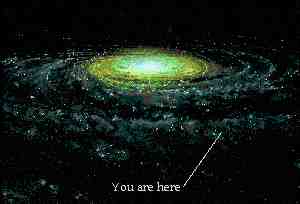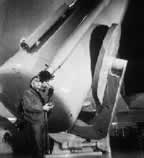At present, those most interested in learning about the interstellar medium are Astronomers and Physicists. However, many people have been involved in its study before now. Scientists and naturalists in the past contributed greatly to the knowledge and information we have today about the materials and objects which surround our planet, and fill our universe.
Here is a brief history of this study:
 Interest in the stars and sky above seems to have been around since the beginning of humankind, but it was not until the time of first early civilizations that people had much time to dedicate to the activity. The earliest of these civilizations were those in Mesopotamia (circa 3500 BCE), Egypt (circa 3000 BCE), India (circa 2500 BCE), Crete (circa 2000 BCE), China (by 1500 BCE), and Central America (by 1000 BCE). These early civilizations studied the sky for both mystical and practical purposes, not for scientific reasons. One of the major reasons for studying the stars was to know when to plant and harvest crops, but the mystical aspects of studying the stars (astrology) soon became a major driving force. There was no study of science distinct from religion up until quite recently, so priests carried out the astronomical interpretation.
Interest in the stars and sky above seems to have been around since the beginning of humankind, but it was not until the time of first early civilizations that people had much time to dedicate to the activity. The earliest of these civilizations were those in Mesopotamia (circa 3500 BCE), Egypt (circa 3000 BCE), India (circa 2500 BCE), Crete (circa 2000 BCE), China (by 1500 BCE), and Central America (by 1000 BCE). These early civilizations studied the sky for both mystical and practical purposes, not for scientific reasons. One of the major reasons for studying the stars was to know when to plant and harvest crops, but the mystical aspects of studying the stars (astrology) soon became a major driving force. There was no study of science distinct from religion up until quite recently, so priests carried out the astronomical interpretation.
The Sumarians (based in Mesopotamia) had developed a written language by circa 3000 BCE. After 2000 BCE, the Babylonians gave this Sumerian cuneiform script a syllabic form, which greatly improved its flexibility. This language was used to record many things, especially astronomical observations. Many of these tablets have survived and allow us to learn a lot about the Babylonian civilization and give us a good record of astronomical analysis for the time period.
The ancient times set the stage for the studies in astronomy which were to come. There were many advances in the field after that, but the knowledge about both the interstellar gas, and the Universe in which it is contained, greatly increased in the Twentieth Century. Tools to study space greatly improved in this time period. By around 1920, much had been learned about the Milky Way. One of the important scientists of the time was Harlow Shapley, an American astronomer who became the director of the Harvard College Observatory. One of Shapley's greatest concerns was determining the size and structure of the Universe. Shapley showed that the sun was not at the center, but that it was orbiting on the side of the disk, approximately 30,000 light years from the center. At the time his studies were first published, in 1917, most astronomers believed that the Milky Way was the entire Universe, with the size of this "known universe" at about 20,000 light years in diameter. It had been mapped, taking stock of the starts in all directions and measuring their distances, by Jacobus Kapteyn. The nature of this analysis had shown that the sun was in the center of this still-small universe. Of course, the very reason that visibility within the Milky Way galaxy had been limited to 20,000 light years was the existence of interstellar gas and dust, though this was not discovered until later. (If this limited visibility is difficult to understand, imagine that you are walking down the street on a foggy night. Even though there may be streetlights all along the street, you will only see the ones closest to you, because the fog will have obscured or blocked out the rest of them.)
 Soon afterwards, two scientists in separate and different studies provided more evidence for Shapley's findings. These two were Jan Oort in Holland, and Bertil Lindblad in Sweden. Both were interested in studying the motion of stars which had been measured by Doppler shifts in their spectra. They showed that there was circular motion of about 220 km/sec about a center -- the center of the Milky Way -- which was very close to where Shapley had predicted it would be. At this point in time (the early 1920's), a lot was known about the Milky Way:
Soon afterwards, two scientists in separate and different studies provided more evidence for Shapley's findings. These two were Jan Oort in Holland, and Bertil Lindblad in Sweden. Both were interested in studying the motion of stars which had been measured by Doppler shifts in their spectra. They showed that there was circular motion of about 220 km/sec about a center -- the center of the Milky Way -- which was very close to where Shapley had predicted it would be. At this point in time (the early 1920's), a lot was known about the Milky Way:
A big question still remained, though: Was the Milky Way all there was to the Universe? Was there nothing beyond its edge? One of the major items regarding this issue concerned spiral nebulae: did they lie within the Milky way or outside of it? This controversy was debated and argued between scientists who disagreed, but it could not be proven one way or the other without a determination of the distances of the nebulae from Earth. This information was to be provided by Edwin Powell Hubble.
 Edwin Hubble is considered to be one of the foremost astronomers of the modern era. At the age of 30, he joined the staff of the Mount Wilson Observatory in 1919. Fortunately for him, they had just commissioned the largest and most effective telescope in the world -- a 100 inch telescope! Using this wonderful new tool, he made extensive observations of some of the brightest nebulae. Through these observations and using laws of astronomy already determined, he was able to determine the distance to the Andromeda nebula. At that time (1924), he calculated a distance of one million light years (latest estimates are 2.5 million). This was far enough to place the Andromeda well beyond the confines of the Milky Way as defined by Shapley. This huge increase in the size of the Universe led to many new areas and objects to explore. Hubble also devised a classification system for galaxies which is still in use today: by this system, galaxies are divided into spiral galaxies (like our Milky way and the Andromeda galaxy), which contain a lot of interstellar gas and dust; and elliptical galaxies, which are almost void of material between their stars.
Edwin Hubble is considered to be one of the foremost astronomers of the modern era. At the age of 30, he joined the staff of the Mount Wilson Observatory in 1919. Fortunately for him, they had just commissioned the largest and most effective telescope in the world -- a 100 inch telescope! Using this wonderful new tool, he made extensive observations of some of the brightest nebulae. Through these observations and using laws of astronomy already determined, he was able to determine the distance to the Andromeda nebula. At that time (1924), he calculated a distance of one million light years (latest estimates are 2.5 million). This was far enough to place the Andromeda well beyond the confines of the Milky Way as defined by Shapley. This huge increase in the size of the Universe led to many new areas and objects to explore. Hubble also devised a classification system for galaxies which is still in use today: by this system, galaxies are divided into spiral galaxies (like our Milky way and the Andromeda galaxy), which contain a lot of interstellar gas and dust; and elliptical galaxies, which are almost void of material between their stars.
One of his greatest discoveries was proving that galaxies move apart from one another. This is seen by a linear relationship between a galaxy's distance and the speed with which it is moving. The ratio of the two is known as the Hubble Constant. In memory of of his great work, the orbiting Hubble Space Telescope also bears his name. An important project of this telescope is to find the value of the Hubble constant to greater accuracy. (The picture seen to the left is Edwin P. Hubble posing with the 48-inch telescope on Palomar Mountain.)
Throughout time, many people have had influence on our study of the interstellar medium. Today, there are numerous scientists working hard to learn the secrets of this material so that we can learn more about the Universe that we live in... where we came from, and where we may be headed. (For more information, also visit the Cosmic and Heliospheric Learning Center's History Pages.)